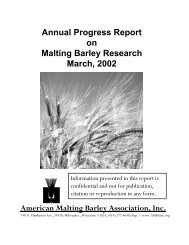Annual Progress Report on Malting Barley Research March, 2007
Annual Progress Report on Malting Barley Research March, 2007
Annual Progress Report on Malting Barley Research March, 2007
You also want an ePaper? Increase the reach of your titles
YUMPU automatically turns print PDFs into web optimized ePapers that Google loves.
Developing Improved Malt <strong>Barley</strong> Varieties for M<strong>on</strong>tana and the Western US<br />
Dr. Tom Blake, Professor, M<strong>on</strong>tana State University<br />
MISSION:<br />
Our missi<strong>on</strong> is to develop the next generati<strong>on</strong> of malting barley varieties for barley<br />
growers in Western North Dakota, M<strong>on</strong>tana, Idaho and the Pacific Northwest. The MSU<br />
barley improvement program has aggressively utilized agr<strong>on</strong>omically superior parents for<br />
the past two breeding cycles, crossing them with excellent malt quality parents and<br />
selecting desirable recombinants. This use of high yield potential, excepti<strong>on</strong>ally durable<br />
lines like Bar<strong>on</strong>esse, Stark, MT851195 and MT860756 as parents has enabled us to select<br />
malt barley lines with agr<strong>on</strong>omic performance nearly equal to the best feed barley<br />
varieties currently available (table 1,2). The c<strong>on</strong>tinuing diversi<strong>on</strong> of corn to ethanol<br />
producti<strong>on</strong> is likely to result in high feedgrain prices for the foreseeable future, making it<br />
even more important to dem<strong>on</strong>strate that our malt barley varieties are agr<strong>on</strong>omically<br />
competitive with feed barley varieties.<br />
The MSU barley improvement program is devoted to improving the farmgate value of the<br />
M<strong>on</strong>tana and US barley crops. We seek to reverse the slide in barley acreage from 1986<br />
(more than 12 milli<strong>on</strong> acres nati<strong>on</strong>ally) to 2006 (less than 3 milli<strong>on</strong> acres nati<strong>on</strong>ally). We<br />
will need to make barley ec<strong>on</strong>omically more competitive with wheat to reverse this<br />
unfortunate trend. While increasing yield will help, increasing quality and the reliability<br />
of our dryland malt barley crop will be critical.<br />
In the past year, we successfully w<strong>on</strong> AMBA recommendati<strong>on</strong> for ‘Craft’ (PI646158),<br />
our first malt barley release with obviously improved agr<strong>on</strong>omic performance. Our<br />
objectives for the next two years are to guide Geraldine and Hockett successfully through<br />
the AMBA plant scale evaluati<strong>on</strong> and recommendati<strong>on</strong> process (tables 1 and 2).<br />
Our project has taken the lead in moving qGPC6H, the ‘Karl’ low grain protein gene <strong>on</strong><br />
chromosome 6, into all of our regi<strong>on</strong>ally adapted varieties. The primary acti<strong>on</strong> of this<br />
gene appears to be to extend grainfill durati<strong>on</strong>, enabling greater starch storage and<br />
perhaps increasing grain yield and possibly malt extract (table 3). We recently purchased<br />
a used Phoenix micromalting unit, and will explore how qGPC6H impacts quality and<br />
agr<strong>on</strong>omic performance in a wide variety of genetic backgrounds and envir<strong>on</strong>ments.<br />
Maximizing US barley’s potential as a starch producti<strong>on</strong> and storage system will improve<br />
our competitive positi<strong>on</strong> relative to corn, while also improving barley’s malting quality.<br />
Over the next five years we need to optimize barley straw as a substrate for cellulosic<br />
ethanol producti<strong>on</strong>, an objective the MSU program began working <strong>on</strong> two years ago.<br />
PRIMARY OBJECTIVE:<br />
The primary objective of the MSU barley improvement program is to improve the<br />
farmgate value and competitiveness of barley for M<strong>on</strong>tana growers. Malt barley provides<br />
growers with added value, and M<strong>on</strong>tana’s positi<strong>on</strong> as a malt barley provider has<br />
improved over the past decade. Enabling M<strong>on</strong>tana’s dryland barley growers to reliably<br />
produce high quality malt barley is our project’s primary goal.<br />
43
















